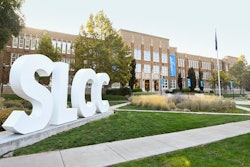‘On The Rez’
The American Indian College Fund’s campaign brings donors to tribal colleges for first-person peek at what their money can do.
By Kerri Allen
The American history Janet Robinson learned growing up in Schenectady, N.Y., in the 1950s presented “a pretty one-sided Anglo perspective” in which American Indians were generally the “bad guys” and English settlers were the “good guys.”
Until recently, Robinson, a retired human resources professional who divides her time between Florida and Connecticut, admits that her knowledge of American Indian culture was derived from travels to places like Mesa Verde, Colo., and from Tony Hillerman novels.
But last winter, Robinson happened upon an advertisement from the American Indian College Fund that set her on a journey to expand her understanding of Native culture as well as the role of tribal colleges. Grabbed by the bold image of the “If I Stay on the Rez” ads and the campaign’s compelling statistics, she logged on to the College Fund’s Web site and made a $300 donation on the spot.
The effective campaign was created by the award-winning ad agency Wieden+Kennedy, which has been donating its services to the AICF since 1991.
W+K co-founder David Kennedy designed six unique display ads, each featuring a tribal college student in the foreground, and a picturesque landscape in the background. Each one displays a different fact about enrollment in a college located on a reservation. “If I stay on the rez, I’m 60 percent more likely to transfer to a four-year university,” says one. “If I stay on the rez, I’m eight times less likely to drop out of college,” reads another.
Kennedy sees the campaign’s success as a simple formula. “They all make a point of why the tribal colleges are beneficial to the students. We just used the statistics and put them in the mouths of students. They’re hard facts served up in an engaging way,” he says. “We just want the public to want to learn more. For a lot of these people,
it’s a lifesaver.”
AICF has received more than $1 million in donated advertising space from magazines like Harper’s and Fortune, enabling the organization to reach millions of readers and potential donors. Individual donations have ranged from $5 to as high as a $6 million bequest with property.
After making her initial contribution, Robinson was invited to one of AICF’s “Journeys for the Mind and Spirit” tours. The organization has sponsored the annual trips since 1995 so donors and the public can learn more about Native lands and tribal colleges. The tours range in length from three to six nights, and participants visit schools and historical sites and attend pow-wows or other cultural events.
This August’s Big Sky tour has been planned around the Crow Fair in Montana.
Robinson went on the tour to South Dakota last June, visiting the Pine Ridge Reservation. “Seeing the graduation at Oglala Lakota College made clear what a joyful accomplishment it was for these graduating students to get their degrees,” she says. “The colleges are also incorporating preservation of Native American languages and culture, which were in the process of being lost in the name of integration.”
Some may argue, however, that plucking a White woman from New England to observe the lives of American Indians sounds like something out of Margaret Mead’s journal.
“Obviously, all of these sites of exhibition are fraught just because of the history and the legacy of display of Native peoples and all of what that entails,” says Dr. Andrew Ross, a professor of social and cultural analysis at New York University. “It may be more fraught for the people who are visiting than for the people who are doing the performance.” He adds that many reservations actively encourage visits, and that programs like Journeys for the Mind and Spirit are “an economic lifeline, part-and-parcel of outreach programs.”
Eileen Egan, the national donor relations officer for the College Fund, says the tribal college students are used to visitors on campus. “Students are all very familiar with the American Indian College Fund. We give about 5,000 scholarships a year to tribal college students. We get letters from students to give to our supporters. They know that this is a College Fund tour. They’re very welcoming, and they’re very happy to share what their experience has been.”
As for the donors, Egan says, “The people who go on [the tours] enjoy the beautiful landscapes, but they say what had the greatest impact is always the tribal colleges, the tribal college students, the graduation [ceremony] — the impact that their support makes on the students’ lives.”
“I would probably not have gone to South Dakota otherwise,” says Robinson. “But I am so glad I did and that I did it this way, with a meansof really appreciating the lifestyle of the local population and, particularly, the indigenous population.”
There are currently 0 comments on this story.
Click here to post a comment.
© Copyright 2005 by DiverseEducation.com





















